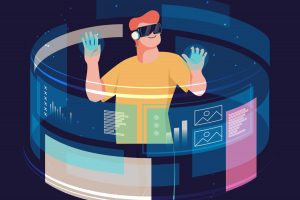Just as mobile apps have evolved way beyond their initial simplicity into multi-functional hubs central to our daily digital experience, the next wave of advancement will come from exploiting predictive AI capabilities to uncover insights that allow apps to understand usage patterns and anticipate user needs sometimes even before conscious awareness.
Navigating the Landscape: The Need for Predictive Analysis

The modern mobile app landscape certainly does not suffer from a lack of options. With over 5 million apps cramming the major app stores in 2023 across every possible category, standing out from the extremely crowded field requires building apps that feel more intuitive, personalized, and smarter to each individual user leveraging the power of predictive analytics.
The “Killer App” Defined – Harnessing Predictive AI Capabilities
Harnessing predictive AI is that next “killer app” defining capability that will likely separate the most innovative apps that users gravitate towards because of their seemingly prescient abilities to serve up hyper-relevant functionality, experiences, and suggestions perfectly matched to contexts and preferences.
Convergence of Factors: Why Predictive Analytics is a Necessity
User Expectations Reimagined
Firstly, user expectations have reached the point where experiences that are personalized based on habits, location, behaviors, and tastes are becoming assumed.
Data Explosion: A Treasure Trove for Predictions
Secondly, the volumes of data being captured from user interactions within apps as well as from complementary sources like connected IoT devices are exploding exponentially.
AI Algorithms Redefining Forecasting
Highly sophisticated AI algorithms leveraging neural networks now exist that can very accurately forecast user wants and future app engagement based on vast datasets.
Democratization of Predictive Tools
Lastly, ready-to-deploy predictive API tools from major cloud platforms like Google and Microsoft greatly lower barriers that previously made predictive analytics complicated for mobile development teams lacking data science expertise.
Innovation in Action: Pioneering Predictive Technology
Ridesharing Platforms Revolutionized
Ridesharing platforms like Uber and Lyft, for example, harness prediction behind the scenes to optimize routing of drivers for quicker pickups and dynamically adjust pricing based on forecasted supply and demand shifts.
Media Streaming Services: A Personalized Experience
Top media streaming services like Netflix, YouTube, and Spotify leverage recommendation engines powered by predictive user preference models to serve up personalized suggestions for video, audio, and text content most relevant to individual tastes.
Finance Apps Forecasting Financial Futures
Finance apps like Mint use forecasting algorithms to anticipate users’ upcoming income, bills, and expenses to then provide customized insights and automated budgeting advice.
Dating Apps: A Futuristic Approach to Matching
Even dating apps like Tinder use predictive matching based on signals beyond explicitly stated preferences to recommend potentially compatible profiles.
E-commerce Apps: Predictive Purchases
And e-commerce apps not only forecast best selling items likely to align with users’ interests but prompt purchases for complementary products based on transaction history predictions.
Key Opportunities for Smarter Mobile Apps
Here are some ways developers can integrate prediction-powered intelligence into mobile apps:
Predict User Actions: Anticipating Needs in Advance
Forecast the functionality or content types each user will likely want access at any moment based on an individual’s past in-app behaviors and journeys.
Location-Aware Features: Enhancing Contextual Relevance
Serve up contextually relevant information, recommendations, or capabilities tuned to a user’s predicted destination and route based on combining app usage history with mobility signals.
Automated Notifications: Proactive Engagement
Send timely and personalized prompts nudging specific actions based on predictive model triggers estimating relevance and impact in context.
Prepopulate Forms: Frictionless User Experience
Reduce friction by filling app input fields, drop-downs, and selections with user data predicted to be most likely desired based on individual precedents.
Dynamic Interfaces: Tailoring User Experience
Continuously reorder menu listings, link prominence, and content visibility ranked by an app’s prediction of what that specific user wants prioritized access to in any moment.
Intelligent Chatbots: Conversational Personalization
Enable natural language conversational interfaces powered by dynamically generated knowledge graphs to answer user queries with responses personalized leveraging profile predictions.
Bringing Predictive Capabilities into Any App
Adding predictive analytics is getting easier for apps. Developers can:
Leverage AutoML Platforms
AutoML low-code tools simplify building, training and integrating predictive models.
Use Predictive Cloud APIs
Services like Google Cloud AI and Azure Cognitive Services provide ready cloud APIs.
Start Small, Scale Up
Focus first on one user workflow. Measure impact then expand predictive features.
Combine Internal and External Data
Blend app usage data with complementary data like weather or traffic to uncover new signals.
Easing the Implementation: From Daunting to Feasible
While integrating advanced analytics may seem daunting, adding basic predictive capabilities is getting easier thanks to autoML platforms that simplify building, training, and deploying models and cloud predictive APIs that provide ready to integrate off-the-shelf solutions.
App Development Companies can start small, focusing on one key user workflow where anticipating needs could differentiate app experience. Once value is proven, prediction features can scale across additional functionality areas and blend data from external sources like mobility, weather and local contextual signals to uncover new behavioral insights.
In Conclusion
In coming years, mobile apps that leverage predictive analytics to uncover hidden insights, learn from users and automate key workflows will likely pull ahead against competitors still relying on reactive approaches. For developers, now is the time to start experimenting with building forward-thinking apps offering users what they want before they even consciously ask for it. The future favors apps that deeply understand human needs and demonstrate that understanding by serving experiences and suggestions that feel almost prescient.




Pingback: Elevating Gaming Narratives: The Impact of AI-Driven Dynamic Storytelling - Quick Startapps
Pingback: Evolution and Impact of AI on Mobile App Development - Quick Startapps